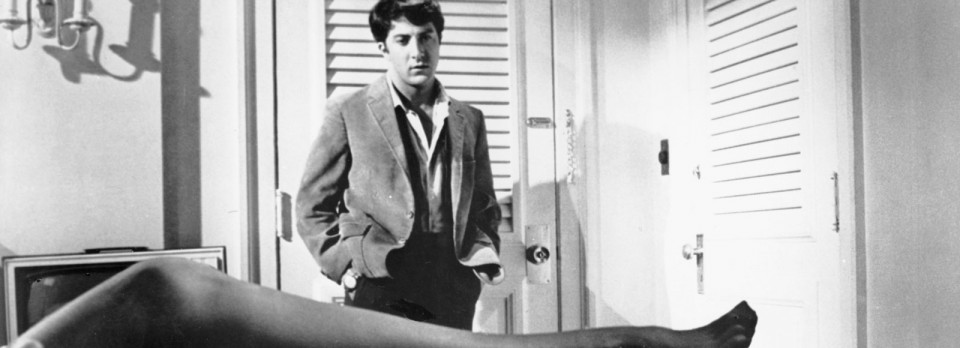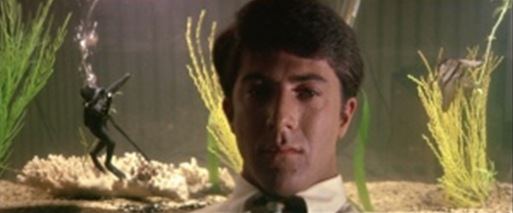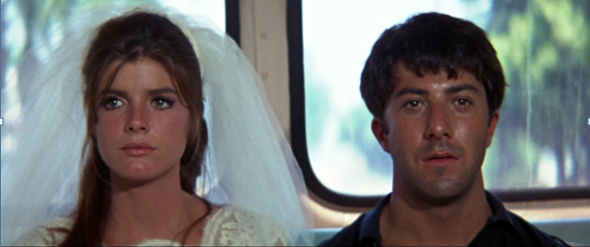The very fact The Graduate has an iconic soundtrack has arguably discouraged examinations of the film’s overall use of sound. Perhaps it is considered too obvious to examine the use of sound in a film which bestows Simon and Garfunkel’s ‘The Sound of Silence’ (1966) with such significance to the film’s protagonist, Benjamin Braddock (Dustin Hoffman), by functioning as an interior monologue for his feelings of “generational disaffection”, disillusionment and isolation. However, The Graduate has not been excluded from film sound criticism altogether. Often coupled with Easy Rider (d. Dennis Hopper, 1969), both are recognised for their similar integration of successful popular music into their soundtracks which spoke directly to the emerging nonconformist American youth of the late 1960s. It is irrefutable the soundtrack alone confirms The Graduate as an auditory masterpiece. However, the intricacies of soundtrack manipulation and the use of other sound devices have yet to be explored in depth.
Dialogue Hook
Although not an established sound technique, I understand the dialogue hook as a repeated phrase of dialogue frames a cut.
Its most notable use in The Graduate subtly connects a conversation between Benjamin and his mother, Mrs. Braddock (Elizabeth Wilson), and Benjamin’s forced conversation with Mrs. Robinson. Whilst shaving, Mrs. Braddock interrogates Benjamin as to where he goes out at night and leaves after she wants answers not dishonesty. Benjamin shouts “Wait! Wait a minute!” in a high-pitched voice as she leaves the screen space. The scene cuts to a dark room barely lit through two half-open window blinds. Whereas the image usually takes precedence in maintaining and creating spatial unity in the diegesis, it is the voice of Benjamin who says “Will you wait a minute please?” which clarifies the dark space as the hotel room where he and Mrs. Robinson frequently meet for their sexual affair. It is the sound, specifically Benjamin’s voice, rather than the image which identifies spatial continuity.
The narrative effects of the repeated words of “wait a minute” connect the two scenes with succinctness that surpasses the capabilities of the visual image and editing alone. Not only does the repeated dialogue liken Benjamin’s behaviour with this mother to his behaviour with Mrs. Robinson, but it reveals his infantile masculinity. Both the former high-pitched yell to Mrs. Braddock and the latter sombre plea to Mrs. Robinson exacerbate the generational gap between Benjamin and the two women and position him as powerless to manage these relationships. This reading of infantile masculinity is supported by several moments where Benjamin’s nervousness and inadequacy result in him whimpering like a child. The dialogue hook, then, works to unveil character behaviour and psychology in a way that can only be achieved through audible signifiers.
Sound Bridging
Like the dialogue hook, sound bridging is understood in film criticism to be transitional device. It can be defined in two ways:
• When the sound from the next scene begins while the images of the last scene are still on the screen
• When the sound lingers briefly while images of the next scene ensue.
A prime example of the first definition of the sound bridge takes place in The Graduate when Benjamin is leaving the Robinson’s household for the first time. A static long shot captures Benjamin walking to his car, away from Mr. and Mrs. Robinson (Murray Hamilton) who are in soft focus and framed by the front door archway. Here Mr. Braddock (William Daniels) is heard in a voiceover saying “Ladies and gentlemen – your attention, please – for this afternoon’s feature attraction.” The scene cuts to a medium shot of Mr. Braddock who continues to introduce Benjamin in his birthday suit. The sound bridge here reinforces Benjamin’s subjection; it is as if he is a puppet being manipulated by all sides and is powerless to the contrasting desires of Mr. Robinson (who wants Benjamin to “sow a few wild oats” and take Elaine out) and Mrs. Robinson (who wants to start a sexual affair with him) as well as being at the mercy of his parents’ wishes on his birthday. The very fact the sound bridge is an audible transition arguably reflects the inexorability of Benjamin’s situation; unable to escape the external pressures of familial and social expectation (and thus the sound representing it). Both the dialogue hook and the sound bridge are in keeping with the film’s overall emphases of generational estrangement and youthful dissatisfaction.
Suspense through Sound in the Final Sequence
The ending of The Graduate has been subject to innumerable critical examinations which often neglect the actions before Benjamin and Elaine run off together on the public bus. There are several notable uses of sound from when Benjamin races to find Elaine after visiting a friend of the rival groom (94.05mins) to the credit sequence (101mins). First, the only song composed solely for the film by Paul Simon, “Mrs Robinson”, is manipulated during Benjamin’s race against time, resulting in distilled sounds of the slap guitar. These sounds are integral to the construction of rhythm and it is this rhythm alone which maintains dramatic effect. The original tempo of “Mrs. Robinson” here is manipulated in synchronisation to the diegetic action; being both accelerated when Benjamin is driving frantically to Santa Barbara and slowed down when his car runs out of petrol. This audible mirroring of the visual action gives pace to an otherwise lengthy chase sequence but it is its relationship to the image which creates its dramatic significance.
As the rhythm fades with the deceleration of car, Benjamin jumps out and runs the rest of the way to the church. The contrast between the preceding manipulated rhythm of “Mrs Robinson” and the white noises of only the wind and passing cars while Benjamin is running creates unbearable suspense. Aligning ourselves with Benjamin with an awareness that this is his last hope to win back Elaine, the lack of nondiegetic sound arguably serves as an audible imitation of the audience ‘holding their breath’ in apprehension. As Benjamin turns the corner and the church becomes visible, five singular guitar strums in ascending scale are heard while he runs up the stairs, into the church and sees the ceremony already over. These five strums are indicative of the film’s climax. Just after Benjamin says “Oh Jesus, God… No”, the sound of the organ precedes and we see Elaine at the altar with her new husband. Benjamin then cries out repeatedly to Elaine in a defeated, sonorous timbre.
The final images of the film capture Benjamin and Elaine on the bus that is slowly driving away from their preordained, conservative lives. Simultaneous to their facial expressions turning from happiness to anxiousness, “The Sound of Silence” starts to play, a song which speaks Benjamin’s feelings of dissatisfaction, disillusionment and isolation. I believe it is only through sound and its powers of suggestion, that The Graduate closes on an anxious, confused note.
It is clear The Graduate is not only homage to New Hollywood’s original yet guarded aesthetic mode, its auditory canvas is intricate and its effects are subtle. From analysing the dialogue hook and the sound bridge respectively, similarities were easily drawn in their abilities to reveal character psychology that surpass the capabilities of the image or editing alone. Finally, an analysis of the film’s ending was inclusive of the diverse devices utilised in creating suspense, dramatic effect and climatic effect.



The Graduate is a very imagist film to, bearing comparison with Godard. There is the repeated camera movement of Ben wheeling to see the predatory Mrs Robinson. Apart from tricks, there’s also almost a Chaplinesque quality to some scenes, sight-gags galore. The Mrs Robinson seduction scene is hilarious for that reason.